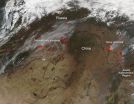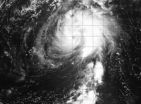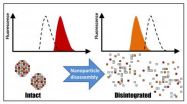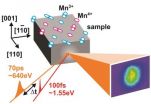(Press-News.org) Boulder, Colo., USA – In an addition to Geosphere's ongoing themed issue series, "Geodynamics and Consequences of Lithospheric Removal in the Sierra Nevada, California," Craig H. Jones of the University of Colorado Boulder and colleagues examine the seismological study of the entire extent of the U.S. Sierra Nevada range using seismograms collected in the Sierra Nevada EarthScope field experiment from 2005 to 2007.
The southern Sierra Nevada is known to have unusually thin crust for mountains with such high elevations (peaks higher than 4 km/14,000 ft, and average elevations near 3 km/10,000 ft). Jones and his team use measurements of the arrival times of seismic waves (called P-waves) from earthquakes around the globe to image the earth under the Sierra Nevada and neighboring locations.
Their results reveal that the entire eastern Sierra overlies low-velocity upper mantle and lacks the dense, quartz-poor lower crust that they say must have existed 80 million years ago when the granites of the range were created.
Jones and colleagues write that this missing dense material probably was removed within the past 10 million years. "Previous workers," they note, "have suggested it might be within a high-velocity mantle anomaly under the southeastern San Joaquin Valley," which is "the right size to be the old, dense rock previously under the eastern Sierra."
They argue, however, that the geometry and extent of earth within the anomaly does not appear to be consistent with it being a piece of old subducted ocean floor. This would mean that a long strip of dense rock under the Sierra somehow deformed into a steeply plunging ellipsoid at the southwestern edge of the range. This conclusion suggests that the range rose within the past 10 million years as this dense material fell away to the west and south. Finally, Jones and colleagues note that something similar might be underway at the northern edge of the range.
Three other new articles posted online on 25 April are highlighted below. All GEOSPHERE articles available at http://geosphere.gsapubs.org/.
Representatives of the media may obtain complimentary copies of GEOSPHERE articles by contacting Kea Giles at the address above. Please discuss articles of interest with the authors before publishing stories on their work, and please make reference to GEOSPHERE in articles published.
Non-media requests for articles may be directed to GSA Sales and Service, gsaservice@geosociety.org.
FEATURED ARTICLE
P-wave tomography of potential convective downwellings and their source regions, Sierra Nevada, California
Craig H. Jones et al., Dept. of Geological Sciences and Cooperative Institute for Research in Environmental Sciences, University of Colorado at Boulder, Colorado 80309-0216, USA. Published online 25 April 2014; http://dx.doi.org/10.1130/GES00961.1. Themed issue: "Geodynamics and Consequences of Lithospheric Removal in the Sierra Nevada, California."
Early Cretaceous construction of a structural culmination, Eureka, Nevada, U.S.A.: Implications for out-of-sequence deformation in the Sevier hinterland
Sean P. Long et al., Nevada Bureau of Mines and Geology, Mail Stop 178, University of Nevada, Reno, Nevada 89557, USA. Published online 25 April 2014; http://dx.doi.org/10.1130/GES00997.1
Documenting the timing relationships between deformation in the frontal and distal parts of mountain belts is fundamental for understanding the dynamics of how they are constructed. In this study, Sean P. Long and colleagues present a new geometric and timing model for deformation in the distal part of the Mesozoic Cordilleran mountain belt in central Nevada. The model is based on new geologic mapping, cross-sections that illustrate the modern and pre-deformed geometry, new age dates from volcanic and sedimentary rocks, and assessment of regional field relationships. Their results reveal that Cretaceous deformation was taking place in the distal part of the mountain belt in Nevada at the same time as deformation in the frontal part in Utah. Long and colleagues use this new timing relationship, along with the predictions of models for the dynamic behavior of the construction of mountain belts, to propose that this deformation in Nevada and Utah was genetically linked.
Paleomagnetic results from the eastern Caliente-Enterprise zone, southwestern Utah: Implications for initiation of a major Miocene transfer zone
Michael S. Petronis et al., Environmental Geology, Natural Resource Management Dept., New Mexico Highlands University, Las Vegas, New Mexico 87701, USA. Published online 25 April 2014; http://dx.doi.org/10.1130/GES00834.1.
The Caliente-Enterprise zone (CEZ) in southwestern Utah (USA) is a 20-50-km-wide, east-northeast-trending, left lateral transfer zone that displaces north-south-trending crustal blocks of the eastern Basin and Range Province to the west. Results of recent detailed geologic mapping and new geochronologic data in the area allow us to extend previous paleomagnetic studies into the easternmost CEZ. New paleomagnetic results reveal significant components of counterclockwise vertical axis rotation. If the rotation estimates are viable, authors Michael S. Petronis and colleagues suggest that this component of deformation involves much of the upper crust, and they furthermore propose that the boundary of the eastern CEZ extends farther east than previously envisioned to within a few kilometers of the breakaway with the Colorado Plateau. The transitional zone between the eastern CEZ and Colorado Plateau is therefore abrupt and occurs within a narrow zone near Cedar City, Utah. As this part of the Hurricane Fault system remains active, they postulate a present-day seismic hazard risk based on ancient faulting and crustal deformation dating back millions of years.
Influence of pre-Andean history over Cenozoic foreland deformation: Structural styles in the Malargüe fold-and-thrust belt at 35° S, Andes of Argentina
José F. Mescua et al., IANIGLA (Instituto Argentino de Nivología, Glaciología y Ciencias Ambientales), Centro Científico Tecnológico Mendoza, Av. Ruiz Leal s/n, Parque General San Martín, Mendoza, 5500, AP 330, Argentina. Published online 25 April 2014; http://dx.doi.org/10.1130/GES00939.1.
This work studies the tectonic evolution of a transect across the Andes of Mendoza, Argentina (35 degrees S) using a combination of structural geology and geophysical techniques. The authors describe the structural styles displayed by this Andean segment, reconstruct the crustal thickness along the transect prior to the uplift of the Andes, and compare the tectonic shortening and present crustal features at the regional scale. The results underscore the importance of the reactivation of old structures in the Andes.
INFORMATION:
http://www.geosociety.org
The thin-crusted US Sierra Nevada Mountains: Where did the Earth go?
2014-04-28
ELSE PRESS RELEASES FROM THIS DATE:
Precise brain mapping can improve response to deep brain stimulation in depression
2014-04-28
Experimental studies have shown that deep brain stimulation (DBS) within the subcallosal cingulate (SCC) white matter of the brain is an effective treatment for many patients with treatment-resistant depression. Response rates are between 41 percent and 64 percent across published studies to date.
One of the proposed mechanisms of action is the modulation of a network of brain regions connected to the SCC. Identifying the critical connections within this network for successful antidepressant response is an important next step.
A new study using MRI analysis of the ...
Wildfire outbreak in far eastern Russia
2014-04-28
According to the Voice of Russia, "As of Saturday morning, in Russia continue 103 wildfires at 27,412 hectares, including big 26 wildfires in the Far East and in Siberia. On Friday, 147 new fires began at 12,509 hectares, and 150 were extinguished at 5,437 hectares. Emergency situation has been introduced in the regions with most complicated situations - in the Amur region, in the Maritime and Baikal territories. This was according to the EMERCOM's (Emergency Control Ministry) spokesperson Alexander Drobyshevsky.
Satellites (such as Aqua and Terra) have located "1,587 ...
Cyberspace scholarship nets higher grades, better thinking for class Facebook group
2014-04-28
University students who used a Facebook group as part of a large sociology class did better on course assignments and felt a stronger sense of belonging, according to a Baylor University study.
The study has implications for the challenge of teaching large classes, a growing concern for higher education. Classes numbering hundreds of students — particularly in introductory courses — have become common at many universities, said researchers Kevin Dougherty, Ph.D., associate professor of sociology in Baylor's College of Arts and Sciences, and Brita Andercheck, a doctoral ...
Newborn Tropical Storm Tapah threatens Saipan and Tinian
2014-04-28
A tropical storm warning is in force for Saipan and Tinian as Tropical Storm Tapah moves north through the Northwestern Pacific Ocean on April 28. When NASA-NOAA's Suomi NPP satellite passed overhead and, imagery revealed a developing eye in Tapah.
In addition to the tropical storm warning, a typhoon watch is in effect for Alamagan and Pagan as Tapah is expected to continue in a generally northerly direction over the next couple of days. A typhoon watch means typhoon force winds of 74 mph or greater are possible within 48 hours. A tropical storm warning means tropical ...
Fluorescent-based tool reveals how medical nanoparticles biodegrade in real time
2014-04-28
Nanoparticles have been heralded as a potential "disruptive technology" in biomedicine, a versatile platform that could supplant conventional technologies, both as drug delivery vehicles and diagnostic tools.
First, however, researchers must demonstrate the properly timed disintegration of these extremely small structures, a process essential for their performance and their ability to be safely cleared out of a patient's body after their job is done. A new study presents a unique method to directly measure nanoparticle degradation in real time within biological environments.
"Nanoparticles ...
A glassy look for manganites
2014-04-28
Manganites – compounds of manganese oxides - show great promise as "go-to" materials for future electronic devices because of their ability to instantly switch from an electrical insulator to a conductor under a wide variety of external stimuli, including magnetic fields, photo-excitations and vibrational excitations. This ultrafast switching arises from the many different ways in which the electrons and electron-spins in a manganite may organize or re-organize in response to such external stimuli. Understanding the physics behind these responses is crucial for the future ...
Ozone levels drop 20 percent with switch from ethanol to gasoline
2014-04-28
A Northwestern University study by an economist and a chemist reports that when fuel prices drove residents of São Paulo, Brazil, to mostly switch from ethanol to gasoline in their flexible-fuel vehicles, local ozone levels dropped 20 percent. At the same time, nitric oxide and carbon monoxide concentrations tended to go up.
The four-year study is the first real-world trial looking at the effects of human behavior at the pump on urban air pollution. This empirical analysis of atmospheric pollutants, traffic congestion, consumer choice of fuel and meteorological conditions ...
Risk of cesarean delivery 12 percent lower with labor induction
2014-04-28
The risk of a cesarean delivery was 12% lower in women whose labour was induced compared with women who were managed with a "wait-and-see" approach (expectant management), according to a research paper published in CMAJ (Canadian Medical Association Journal).
Labour is induced in about 20% of all births for a variety of reasons such as preeclampsia, diabetes, preterm rupture of the membranes, overdue pregnancy and fetal distress. Induction is often thought to be associated with increased risk of cesarean deliveries despite evidence indicating a lower risk. However, much ...
Catastrophic thoughts about the future linked to suicidal patients
2014-04-28
Suicide has been on the increase recently in the United States, currently accounting for almost 40,000 deaths a year. A new study shows that one successful effort to avoid suicide attempts would be to focus on correcting the distorted, catastrophic thoughts about the future that are held by many who try to kill themselves. Such thoughts are unique and characteristic to those who attempt suicide, says Shari Jager-Hyman of the University of Pennsylvania Perelman School of Medicine in the US. Jager-Hyman led a study, published in Springer's journal Cognitive Therapy and ...
Identification of genetic mutations involved in human blood diseases
2014-04-28
A study published today in Nature Genetics has revealed mutations that could have a major impact on the future diagnosis and treatment of many human diseases. Through an international collaboration, researchers at the Montreal Heart Institute (MHI) were able to identify a dozen mutations in the human genome that are involved in significant changes in complete blood counts and that explain the onset of sometimes severe biological disorders.
The number of red and white blood cells and platelets in the blood is an important clinical marker, as it helps doctors detect many ...




